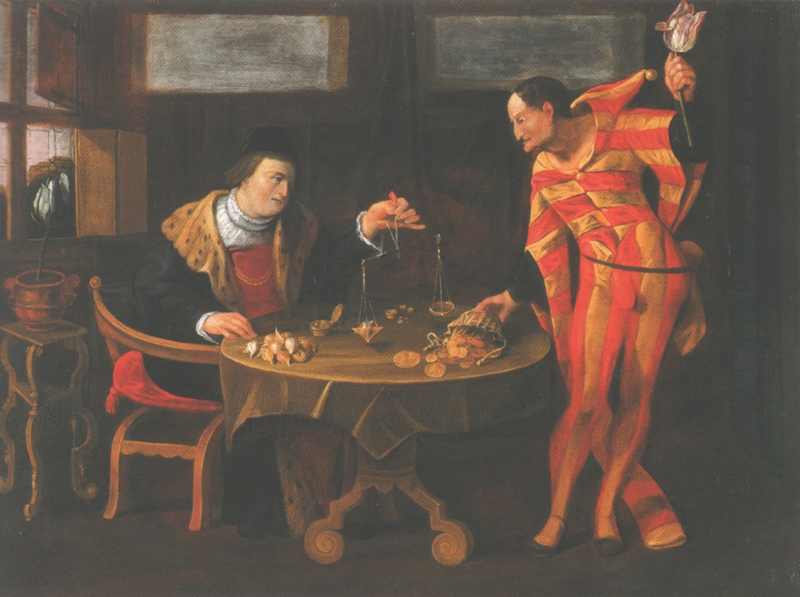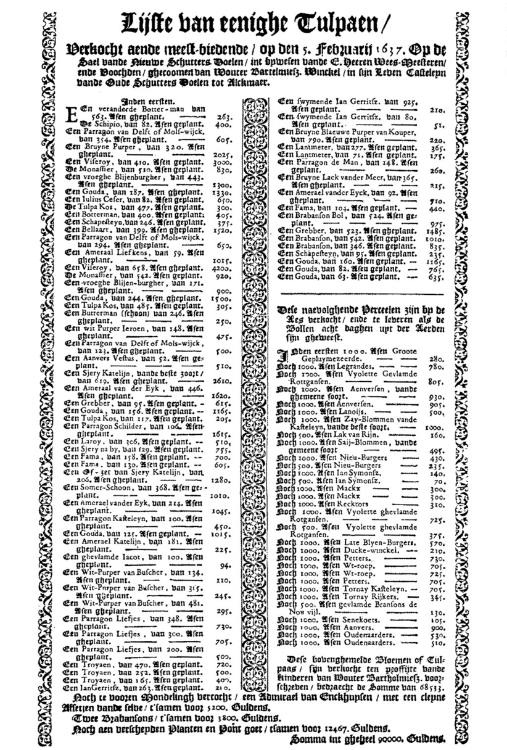"Tulip mania": an exchange bubble that did not exist
- Transfer

Image: Wikimedia commons
Smithsonian, a scientific publication, published material that the "tulip fever", which is considered to be the first exchange bubble, was invented by the Dutch Calvinists. People pursued profit, but not as enormously as described in textbooks and fiction. And this race certainly did not cause the collapse of the economy and industry. We have prepared a Russian-language adaptation of this article.
Total insanity
When the first tulips were grown in the Middle East, the whole world went crazy. Some varieties were worth more than gold. There is a legend that the sailor was charged with a criminal offense and sent to prison only because he confused the tuber of a rare tulip with an ordinary bulb and ate it for lunch. One bulb of the rare Semper Augustus variety, with flowers from red and white petals, stood like a mansion in the fashionable Amsterdam area, with a personal trainer and garden in addition. As the cost of tulip in the market grew, a wave of speculation began - traders raised the prices of bulbs to heaven. And then, as is usually the case with exchange bubbles, the tulip market “burst”, leaving hundreds of sellers without revenue.

The dynamics of the index of futures (green) and optional (red) prices for bulbs in the years 1635-1637 according to Thompson. Picture:Wikimedia Commons
For several decades, economists have set the story of “tulip mania” as an example of the dangers and instability of the free market. Writers and historians have written hundreds of books about the absurdity of events. A film was even made on this subject, it is called Tulip Fever , its plot is based on a book by Deborah Moggch.
There is only a small nuance: this story is not true.
To understand the truth, you need to understand the story
What really happened and how did it happen that the history of tulip speculation in Holland was so distorted? Anne Goldgar, professor of early modern history at Queen's College London, discovered the truth when she studied archives to create Tulip Mania: Money, Honor, and Knowledge in Holland's Golden Age.
“I always joke that the book should be called Tulip Mania: It's Boringer Than You Think,” Goldgar says. “People like this legend because they think they can learn a lesson from it. I consider this opinion erroneous. "
Before you put the “tulip fever” on a par with the bubble of the South Sea, which happened in England in the 1700s, with the railway bubble of the 19th century, with the bubbles of dotcoms and bitcoins, it is worth studying several arguments of Professor Goldgar and understanding what happened in Dutch society at the turn of the XVII century.
It is worth starting with the fact that the country experienced a major demographic shift during the war of independence with Spain. During this period, merchants arrived in large port cities: Amsterdam, Harlem, Delft and began trading, including the famous Dutch East India Company. This brought a huge income to Holland, even despite the martial law in the country. At the head of the new independent nation was the urban oligarchy, consisting of wealthy merchants, in contrast to other European countries of that era, which were controlled by the nobility. As a result, new faces, ideas, and money helped revolutionize the Dutch economy in the late 16th century.
As the economy has changed, social interactions and cultural values have changed. A growing interest in natural history and a love of exoticism among merchants caused an increase in prices for goods from the east, including from the Ottoman Empire. People of all social classes had to develop in new directions, which appeared with the influx of new goods. For example, a fish auctioneer created the manuscript Book of the Whales, and this work allowed him to meet with the president of Holland. The Dutch botanist Klusius created a botanical garden at the University of Leiden in 1590 and the tulip quickly rose to a place of honor.
“The wild tulips found in the Tien Shan valleys began to be bred in Istanbul in 1055, and in the 15th century they already became symbols of the Ottomans. For example, Sultan Mehmed II had 12 gardens with tulips, which required 920 gardeners to maintain, ”says Anna Pavord, gardening correspondent for The Independent, an online publication in Tulips.
The Dutch deduced that tulips can be grown from seeds and processes of the mother’s bulb. It takes from 7 to 12 years for a bulb to grow from a seed and a flower to bloom. And a ripened bulb can become a tulip in a year. Of particular interest to the botanist Clusius and the “tulip speculators” were “broken bulbs”. The petals of the tulips that grew from these bulbs were not monophonic, but multi-colored. It was impossible to predict what the future flower would look like. Naturalists came up with ways to reproduce such bulbs and buds, as the demand for this rare species has been constantly growing. As it turned out later, this effect was due to the fact that the bulbs hurt. They were frail and rarely gave flowers.
“The high market value of tulips, about which authors studying“ tulip mania ”write, was caused by prices for particularly beautiful“ broken bulbs, ”writes economist Peter Garber,“ since it was impossible to predict what a flower sprouted from such a bulb would look like “Tulip mania can be described as a game of chance among manufacturers who sought to grow buds of an increasingly unusual coloring.”

A printed report on the results of the auction in Alkmaar on February 5, 1637. Image: Wikimedia commons
Dutch speculators spent all their money on bulbs, and then they grew flowers, among which, perhaps, only one would make a profit. “As luxuries, tulips fit well into a culture of big capital and new cosmopolitanism,” Goldgar writes. Tulips required expertise, experience in assessing beauty and exoticism, and, of course, a lot of money.
Legend Beginning
This is where myth comes into play. According to a popular legend, “tulip mania” embraced all levels of Dutch society in 1630. "The desire of the Dutch to possess rare bulbs was so great that ordinary industry was abandoned, and the population, down to the lowest layers, began to sell tulips," writes Scottish journalist Charles Mackay in the popular work of 1841, "Extremely popular delusions and insanity of the crowd." According to this work, everyone, from the richest merchants to the poorest chimney sweeps, bought tulip bulbs and resold them at a higher price. Most tulip companies were at the end of 1636, and in February the market began to crack at the seams. More and more people went bankrupt, hoping to buy the cherished onions, and more and more merchants, left in debt, became bankrupt.
“In fact, few people were involved and the economic consequences were not so significant,” writes Goldgar, “I could not find information on at least one bankrupt in the archives. If there really was a mass destruction of the economy, as the myth says, finding data would not have been difficult. ”
These arguments do not mean that everything in the story of “tulip mania” is fiction. Traders really participated in the frantic tulip trade and paid unthinkable money for several bulbs. And when buyers could not pay the merchants as much as they had promised in advance, the market fell apart and caused a small crisis. But just because it undermined social expectations.
“In this case, the difficulty is that almost all market relations were built on trust. The buyers promised to buy the bulbs from the merchants, and then they said, “I don’t care that I promised to buy it. Now I do not need this product. " The courts did not want to interfere in this and therefore there was no one to force people to pay for the goods, ”Goldgar says.
But “tulip mania” did not affect all sections of society and did not cause the collapse of industry. “The lack of bankruptcy data does not allow a firm conclusion, but the results of the study suggest that speculation with tulip bulbs was not as massive and crazy as is commonly believed,” writes economist Peter Garber.
Who spread the myth?
If “tulip mania” was not such a disaster, why was it put up in this light? It can be assumed that offended Christian moralists are to blame for this. With great wealth comes a wave of social unrest. “An incredible level of success turned their heads. All incredible stories confirming economic devastation: about a sailor thrown into prison and about chimney sweeps trying to get rich, came from propaganda brochures. They were distributed by the Dutch Calvinists, who were afraid that the tulip boom would lead to social decay. Their belief that this wealth was terrible has survived to the present day, ”writes historian Simon Scham, in the book“ Confusion of wealth: Interpretation of Dutch culture in the Golden Age ”.
“Some ideas are ineradicable, for example, that God does not like the cunning and sends a plague on them. That's what people could say in 1630, says Anne Goldgar, the idea that cunning is a sin has survived into modern society. Pride precedes the fall. ”
Goldgar does not condemn directors and writers for misinterpreting the past. She is dissatisfied with the incorrect conclusions of historians and economists, which they made in their works, further spreading the idea of "tulip mania." “I had no way of knowing that this story was a lie until I picked up the old archives. It was an unexpected treasure, ”Goldgar says.
Other materials on the topic of finance and stock market from ITI Capital :
- Analytics and market reviews
- Futures, Indices and IPOs: How Exchanges Are Actually Arranged and Why They Are Needed
- Top 10 books for understanding the structure of the stock market
- Futures, Indices and IPOs: How Exchanges Are Actually Arranged and Why They Are Needed
- Infrastructure of the Russian securities market (short educational program)
- How-to: robots and brokerage trading system API
